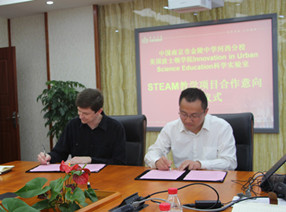
-
09
2020/09金陵中学河西分校国际部教师概况国际部发展十余年来,有着一批高素质,专业化的专职教师团队。 目前,国际部教师88名,中教66名,外教22名,外教占比25%,师生比17.6%,硕士及以上是100%,并具有在国际一流高校执教或研究工作经验,平均教龄在9年以上,是一群具有国际视野、富有创新精神、积极进取、思维活跃和站在学科前沿的中青年教师队伍。 2019年10月,全省首个博士工作站在金中河西国际部成立,11位海内外博士正式受聘为“金陵中学河西分校博士工作站”成员,并将在学校国际部教授专业课程。以博士为引领,以学科为纽带,以研究为核心的教师专业合作组织正式形成。它将发挥着拓展高学历教师自我发展空间、发挥博士生研究特质、开展教育最前沿课题或项目研究、促进研究型教师成长等的重要作用。 -
17
2020/06南京市教育科学“十三五”规划2020年度立项课题名单南京市教育科学“十三五”规划2020年度课题立项名单已公示,国际部戴慧敏老师课题获得立项。恭喜戴慧敏老师! -
17
2020/062020年度建邺区优秀教育案例、教育叙事征文评选结果公示2020年度建邺区优秀教育案例、教育叙事评审结果已公示,我校共获一等奖32人,其中推荐报市16人,二等奖37人,三等奖20人。恭喜以下获奖教师! -
17
2020/062020年建邺区“黄浦杯”论文评审结果公示2020年度建邺区“黄浦杯”长三角城市群“创新视角下的教育现代化” 教育征文评比结果已公示,我校国际部刘畅老师凭借论文《项目化学习——英语听口课堂教学现代化初探》获得了C区二等奖。恭喜刘畅老师! -
17
2020/062020年骨干教师示范课安排为了充分发挥骨干教师示范课的引领示范作用,充分调动职初教师的听课积极性,帮助职初教师快速成长,金陵中学河西分校国际高中于6月3日-4日开展“骨干教师示范课”活动。全国际学校教师认真完成听课笔记,从“综合评价”、“教学亮点”、推荐教师学习的做法或技术等方面总结与反思,11位职初教师课后认真撰写“骨干教师示范课”听课反思。具体安排如下: -
22
2016/04 美国STEM项目负责人来校开讲并签订合作协议2016年4月22日,美国总统“下一代教育计划”顾问、国家科学基金会委员、国际课程STEM(SCIENCE, TECHNOLOGY, ENGINEERING AND MATHEMATICS)开发者,美国名校波士顿学院教授迈克尔·巴奈特(Michael Barnett)来到金陵中学河西分校就在我校建立STEM课程基地开展了一系列交流活动。 上午八时,巴奈特教授为我校国际部高一(6)班的同学们上了一堂物理公开课《电动机》。巴奈特教授首先通过师生问答检测了学生知识储备,并拿出了相应的探究性学习方案。正课开始,教授展示了微型电动机构在现代生活中无处不在,并且介绍了其机械构成及其运作原理。随后,教授把主动权交给学生,交给黄铜线圈、电流表、磁铁,手把手指导学生们根据法拉第原理制作自己的电动机。教授带来的原汁原味、以实践为中心的美式课堂,激起了学生的强烈求知欲,锻炼了他们的动手能力,同时加深了学生对物理学定律的理解。 示范课结束后,巴奈特教授为我校教师和媒体记者做了名为《STEM课程的开发及实施》的主题讲座。详细介绍了美国STEM课程发展的历史,美国一高中开展STEM项目的成功案例,以及项目运作的具体目标、方案和评价体系。国际部郭擎川老师等提出的就项目技术支持、家校合作和国际交流管道等问题做出了详尽解释。国际部的双语科学课一直在业内享有盛誉。这次巴奈特教授来访也饶有兴致的旁听了国际部端木丹丹老师执教的化学公开课,并在课后就中美教育差异,国际课程如何“中国化”等问题与中方教育和媒体人士交换了宝贵意见。 观察课结束后,学校领导参加了美国波士顿学院STEM项目合作签约仪式,巴奈特教授与朱焱校长共同签署了项目合作意向书。美国波士顿学院科学实验室负责提供生态农业、环境科学、创客空间等课程,为实验室建设提供技术支持和教师培训,双方定期进行教师交流,金陵中学河西分校的学生可以在波士顿学院科学实验室进行美式课程体验与学习。STEM即科学(Science)、技术(Technology)、工程(Engineering)与数学(Mathematics)的缩写,STEM教育创新理念鼓励学生在科学、技术、工程和数学领域加大学习,
美国STEM项目负责人来校开讲并签订合作协议2016年4月22日,美国总统“下一代教育计划”顾问、国家科学基金会委员、国际课程STEM(SCIENCE, TECHNOLOGY, ENGINEERING AND MATHEMATICS)开发者,美国名校波士顿学院教授迈克尔·巴奈特(Michael Barnett)来到金陵中学河西分校就在我校建立STEM课程基地开展了一系列交流活动。 上午八时,巴奈特教授为我校国际部高一(6)班的同学们上了一堂物理公开课《电动机》。巴奈特教授首先通过师生问答检测了学生知识储备,并拿出了相应的探究性学习方案。正课开始,教授展示了微型电动机构在现代生活中无处不在,并且介绍了其机械构成及其运作原理。随后,教授把主动权交给学生,交给黄铜线圈、电流表、磁铁,手把手指导学生们根据法拉第原理制作自己的电动机。教授带来的原汁原味、以实践为中心的美式课堂,激起了学生的强烈求知欲,锻炼了他们的动手能力,同时加深了学生对物理学定律的理解。 示范课结束后,巴奈特教授为我校教师和媒体记者做了名为《STEM课程的开发及实施》的主题讲座。详细介绍了美国STEM课程发展的历史,美国一高中开展STEM项目的成功案例,以及项目运作的具体目标、方案和评价体系。国际部郭擎川老师等提出的就项目技术支持、家校合作和国际交流管道等问题做出了详尽解释。国际部的双语科学课一直在业内享有盛誉。这次巴奈特教授来访也饶有兴致的旁听了国际部端木丹丹老师执教的化学公开课,并在课后就中美教育差异,国际课程如何“中国化”等问题与中方教育和媒体人士交换了宝贵意见。 观察课结束后,学校领导参加了美国波士顿学院STEM项目合作签约仪式,巴奈特教授与朱焱校长共同签署了项目合作意向书。美国波士顿学院科学实验室负责提供生态农业、环境科学、创客空间等课程,为实验室建设提供技术支持和教师培训,双方定期进行教师交流,金陵中学河西分校的学生可以在波士顿学院科学实验室进行美式课程体验与学习。STEM即科学(Science)、技术(Technology)、工程(Engineering)与数学(Mathematics)的缩写,STEM教育创新理念鼓励学生在科学、技术、工程和数学领域加大学习, -
18
2016/04双语化学组发表论文情况1.《Amino-Directed Rh(III)-Catalyzed C–H Activation Leading to One-Pot Synthesis of N–H Carbazoles》 2.《Mixed-valent diruthenium half-sandwich complex containing two chelating 1,2-dicarba-closo- dodecaborane-1,2-dithiolate ligands: Reactivity toward (cyclo-C6H10)(OH)CCH and PhC(O)CCH》 -
18
2016/04双语物理组论文发表情况美国高中物理教材中的激励艺术 美国高中物理课堂特色之我见——重视知识产生和发展过程的分析 浅谈美国高中物理教材的特点 Mechanical stress effect on the crystallization behavior of Ge2Sb2Te5 films studied by electrical resistance measurement Kinetics of linear domains in LiNbO3 single crystals polarized by scanning probe microscopy Mechanical stress modified ferroelectric aging behavior The study of QCD phase transition at finite temperature and chiral chemical potential in a Dyson-Schwinger Equation model -
13
2016/04Types of Chemical ReactionsTypes of Chemical Reactions 1. Synthesis Reactions A+B → AB 1) When both A and B are elements; e.g. 2 Na (s) + Cl2 (g) → 2 NaCl (s) When Iron Rusts, 4 Fe (s) + 3 O2 (g) → 2 Fe2O3 (s) 2) When both A and B are compounds; Two compounds can also combine to form one product. 2 SO2 (g) + O2 (g) → 2 SO3 (g) 3) When the reaction is between a compound and an element. 2. Combustion Reactions The conditions for combustion: (1) Something flammable; (2) At the right temperature to ignite; (3) Mixed with fresh air (oxygen). There are two characteristic features of combustion reactions: (1) Reactants include oxygen; (2) Release a large amount of energy in the form of heat and light. e.g. 2 H2 (g) + O2 (g) → 2 H2O (l) Hydrocarbon (1) An organic compound consisting entirely of hydrogen and carbon; (2) When burning in oxygen, it generates carbon dioxide and water. 3. Decomposition Reactions AB → A + B A or B can not only be element, but also be new compound. e.g. CaCO3 -
13
2016/04Properties of Trigonometirc FunctionWarming up Properties of Sine, Cosine & Tangent Functions Domain & Range Positive or Negative in quadrants Parity: Even or Odd Symmetry Graph





